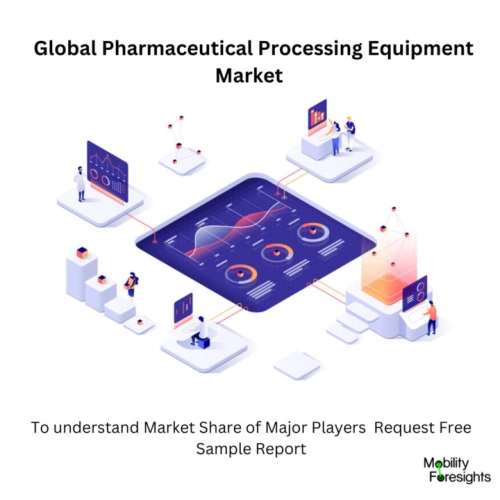
- Get in Touch with Us

Last Updated: Apr 25, 2025 | Study Period: 2024-2030
The gear and systems used in the production and processing of pharmaceutical goods are referred to as pharmaceutical processing equipment. These specialist tools are created to satisfy the exacting standards of the pharmaceutical sector, guaranteeing the creation of medicines that are reliable, efficient, and of the highest caliber.
From the preparation of raw materials through the packing of the finished product, pharmaceutical processing machinery performs a wide range of tasks. Active pharmaceutical ingredients (APIs) and excipients are distributed uniformly by homogeneously mixing various substances using blending and mixing equipment.
To regulate release profiles or enhance flavor, coating machines cover tablets, capsules, and other solid dosage forms with a protective or functional coating. Systems for drying materials eliminate moisture, assuring stability and inhibiting the growth of microbes. To remove particles and bacteria from liquids, filtering equipment is utilized.
To guarantee the safety, effectiveness, and quality of pharmaceutical goods, pharmaceutical processing equipment must abide by stringent regulatory standards, including Good Manufacturing Practices (GMP).
These tools are essential for making pharmaceuticals that adhere to the highest industry requirements. For the purpose of maintaining a regulated environment during pharmaceutical manufacture, cleanrooms are necessary.
Laminar flow hoods, isolators, and air filtration systems are among the equipment. Pharmaceutical items are tested for quality and purity using analytical tools like high-performance liquid chromatography (HPLC), mass spectrometers, and spectrophotometers.
These devices use liquid goods to fill containers and then cover them with closures or caps. Packaging machines label and seal completed pharmaceutical items inside of cartons, bottles, and blister packs.

The Global pharmaceutical processing equipment market accounted for $XX Billion in 2023 and is anticipated to reach $XX Billion by 2030, registering a CAGR of XX% from 2024 to 2030.
Once a pharmaceutical firm receives regulatory permission, a quick product launch is critical, and a sluggish transfer of technology from R&D to manufacturing might lose vital market share. The transmission of information about new products and procedures from product development to manufacturing is known as technology transfer.
It may also comprise the transfer of information about existing products and processes through purchase, merger, and production outsourcing.
Tech transfer is a broad and complicated process that necessitates knowledge of equipment, automation, procedures, roles and duties, competences, and training requirements, in addition to knowledge of products and processes. Misunderstandings in this procedure can result in serious errors and delays, as well as significant economic effects.
| Sl no | Topic |
| 1 | Market Segmentation |
| 2 | Scope of the report |
| 3 | Abbreviations |
| 4 | Research Methodology |
| 5 | Executive Summary |
| 6 | Introduction |
| 7 | Insights from Industry stakeholders |
| 8 | Cost breakdown of Product by sub-components and average profit margin |
| 9 | Disruptive innovation in the Industry |
| 10 | Technology trends in the Industry |
| 11 | Consumer trends in the industry |
| 12 | Recent Production Milestones |
| 13 | Component Manufacturing in US, EU and China |
| 14 | COVID-19 impact on overall market |
| 15 | COVID-19 impact on Production of components |
| 16 | COVID-19 impact on Point of sale |
| 17 | Market Segmentation, Dynamics and Forecast by Geography, 2024-2030 |
| 18 | Market Segmentation, Dynamics and Forecast by Product Type, 2024-2030 |
| 19 | Market Segmentation, Dynamics and Forecast by Application, 2024-2030 |
| 20 | Market Segmentation, Dynamics and Forecast by End use, 2024-2030 |
| 21 | Product installation rate by OEM, 2023 |
| 22 | Incline/Decline in Average B-2-B selling price in past 5 years |
| 23 | Competition from substitute products |
| 24 | Gross margin and average profitability of suppliers |
| 25 | New product development in past 12 months |
| 26 | M&A in past 12 months |
| 27 | Growth strategy of leading players |
| 28 | Market share of vendors, 2023 |
| 29 | Company Profiles |
| 30 | Unmet needs and opportunity for new suppliers |
| 31 | Conclusion |
| 32 | Appendix |